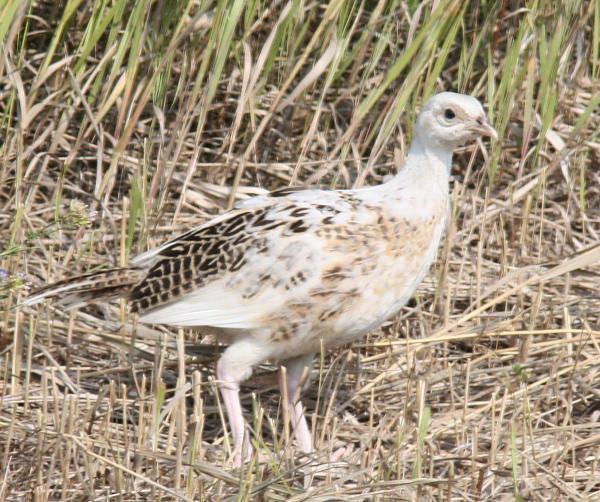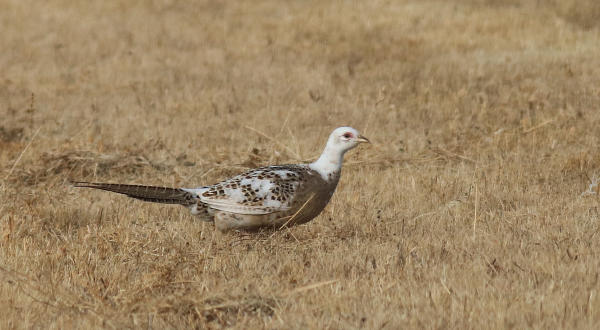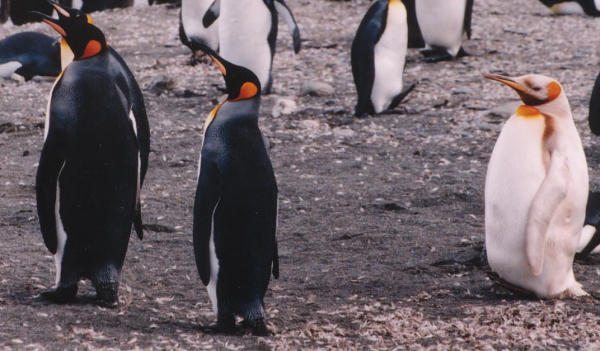
A partial-albino Ring-necked Pheasant fledgling.

An adult female partial-albino Ring-necked Pheasant.

A partial-albino Canada Goose near a pair of Giant Canada Geese. Judging by the size of the leucocistic goose, it is probably a smaller race of Canada Goose that nests in central Canada.

A partial-albino King Penguin was among hundreds of thousands of normal Kings.
|
Documentary photography isn’t the same as most uses for your camera. There doesn’t need to be great lighting, high resolution or thoughtful composition; you just want to document a rare bird, or an interesting sighting, an unusual plumage feature or a special behavior.
First, I can’t emphasize enough how helpful a photo is when you encounter a bird that makes you think twice about your identification. When working as a wildlife biologist, this is more important than when I’m birding; but nonetheless, it’s helpful in the same way. During a quick, distant look at a bird of semi-questionable identity, I take a quick photo or two and double-check my initial I.D. to be sure it was correct. When I download that photo on the big screen of my laptop and enlarge the image at will, I’m sometimes surprised to see what details are obvious that I didn’t see in the field, even with binoculars. Sometimes things happen fast and you just get a quick view – a photo can help appreciably.
Rare bird sightings really need to be documented with a photograph; and again, the photos don’t need to be technically correct, they just need to be recognizable. Many states have birding committees that review rare bird sightings to try to verify them, and the best way to pass the committee muster is to provide a documentary photograph in addition to your written sighting description.
The first rare bird I found was a Varied Thrush in my boyhood backyard. Since then, I haven’t found many “rare birds,” or birds found far beyond their normal ranges, but I have had the privilege of finding and documenting some unusual birds that I consider especially rare – partial albino birds. Some of the partial albino (leucocistic) birds I can remember include two Ring-necked Pheasants (photographed about 15 years apart), an early spring Canada Goose, a Red-tailed Hawk that returned to the Lost Road prairie two years in a row, an American Coot, a male Red-winged Blackbird, two Blacksmith Plovers (in Zambia) and a King Penguin (South Georgia). All of these birds provided memorable documentary photographs, and all have been exciting finds.
Documentary photos are also very helpful for record-keeping. If you’re organized and keep accurate birding records, photographs add a lot to your reports. Likewise, eBird reports are certainly enhanced by photos that birders attach. And if you’re less concerned about rigorous record keeping, your photographs provide a good indication of what you observed and when. Most cameras place an “invisible” stamp on each photo that contains the date, time and location that documents when and where the photo was taken.
If you’re a serious photographer, you probably have a camera within reach at all times, because you never want to start any story with the old line, “I wish I woulda had my camera.” Today, almost everyone has a camera within reach in the form of a smart phone camera (phone/camera/computer/TV/radio/jukebox/voice recorder/clock/ alarm/scheduler/calculator/files/etc). When in doubt, document your sightings with photos – and you may even get some fine photographs in the process.
Article and photographs by Paul Konrad